Aboriginal peoples of Tasmania are the first people who lived on the island of Tasmania and their modern descendants. Tasmania lies off the southeastern coast of the Australian continent. Tasmania’s Aboriginal people are part of the larger Aboriginal population of Australia, which also includes the Aboriginal peoples of the mainland and some other islands. The Aboriginal peoples of Australia include several hundred distinct peoples (groups) with diverse cultures and languages. For more information, see Aboriginal peoples of Australia.
The word aboriginal comes from the Latin phrase ab origine, meaning from the beginning. Spelled with a small a, the term refers to any people whose ancestors were the first to live in a country. The term Indigenous peoples of Australia also is used to refer to both the Aboriginal peoples of Australia and the Torres Strait Islander peoples, a separate collection of cultural groups from the Torres Strait Islands north of Queensland. The word indigenous means native. Australians also use the terms First Australians and First Nations peoples when referring to Aboriginal and Torres Strait Islander peoples. For more information, see Indigenous peoples of Australia and Torres Strait Islander peoples.
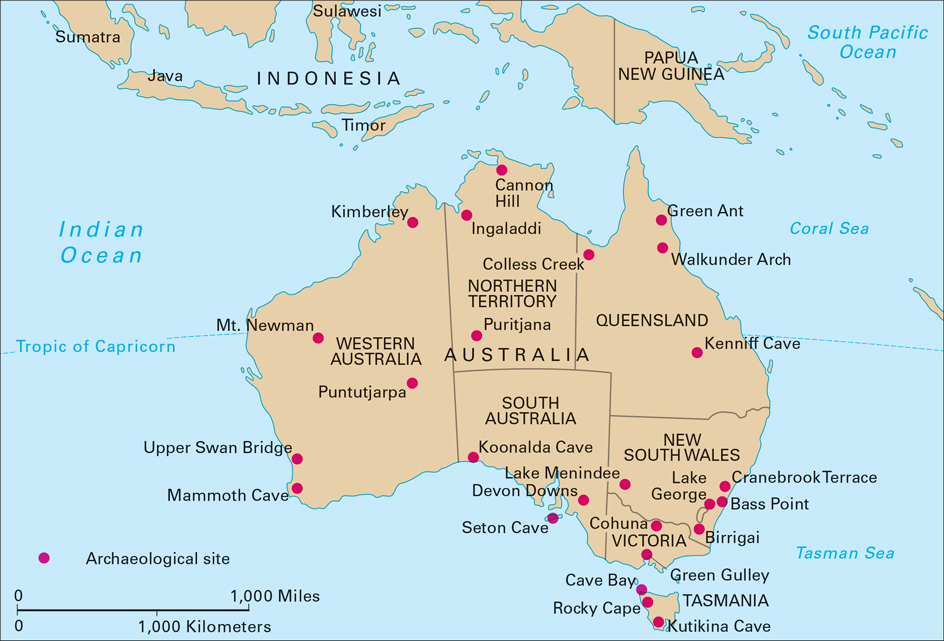

According to Aboriginal traditions, Aboriginal people have always lived in Australia. Scientists have found evidence that suggests Aboriginal people have lived in Australia for more than 65,000 years. Archaeological findings indicate that Aboriginal people arrived on what is now the island of Tasmania by about 40,000 years ago. About 4,000 Aboriginal people lived there when Europeans first sighted Tasmania in 1642.
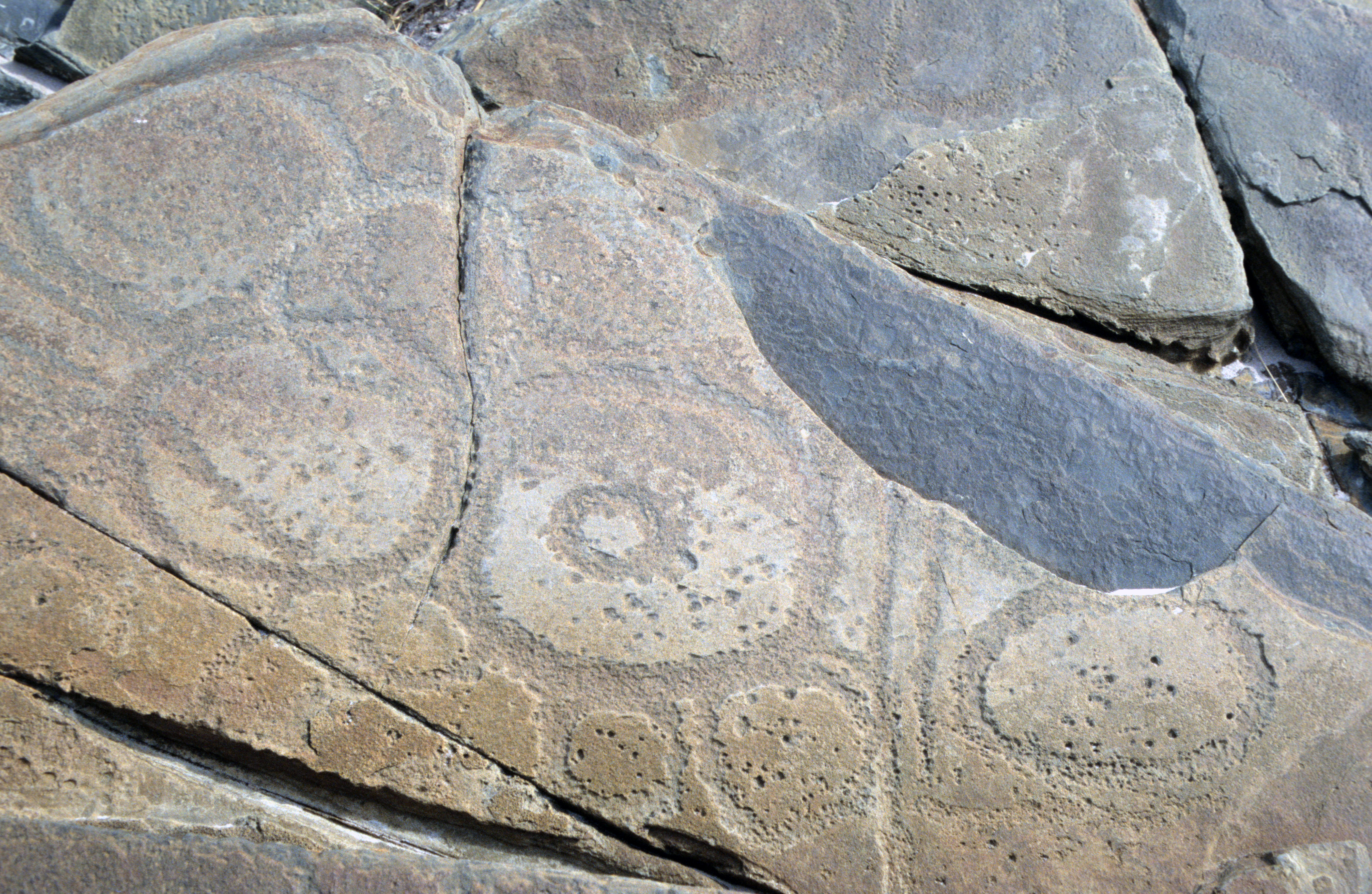
European colonizers began to establish settlements on Tasmania in 1803. They also began to take control of Aboriginal lands. Diseases brought by the Europeans, violent conflicts with the settlers, and the loss of land along with the traditional foods and resources it supplied greatly reduced the Tasmanian Aboriginal population. In the mid-1800’s, colonial authorities removed most of the Aboriginal people from Tasmania and resettled them on Flinders Island, where most of the relocated people died.
Since the mid-1900’s, the Aboriginal peoples of Tasmania and of mainland Australia have gained many civil rights, as well as respect for their cultural heritage. Today, many Aboriginal people of Tasmania maintain their traditional culture while working to reclaim some of the land they lost to the European colonizers.
Traditional way of life
Before the European colonization of Australia, the continent’s Aboriginal peoples had complex social systems and beliefs. The social organization, daily life, art, and religion of Tasmania’s Aboriginal people resembled those of the mainland Aboriginal groups. However, Tasmanian Aboriginal culture developed unique aspects as well.
Social organization.
Scholars suggest that the Aboriginal peoples of Tasmania had three levels of social organization. The smallest group was the hearth group, which was similar to the family group on the Australian mainland. The hearth group typically included the husband and wife, their children, and a few other relatives. This group cooked and camped around a single fire.
The next larger group was the band, which was probably similar to the mainland clan. The band was the basic landowning group and consisted of several hearth groups. Aboriginal people had to marry someone from a different band. People from neighboring bands could hunt in each other’s homelands.
The tribe was the largest group. Aboriginal Tasmanians were grouped into about nine tribes, probably ranging in size from 250 to 700 people. Like the mainland Aboriginal peoples, the Tasmanians used language and dialect to define these groups. Each tribe was made up of a number of bands that lived in adjoining territories, spoke the same language or dialect, and shared the same cultural traits.
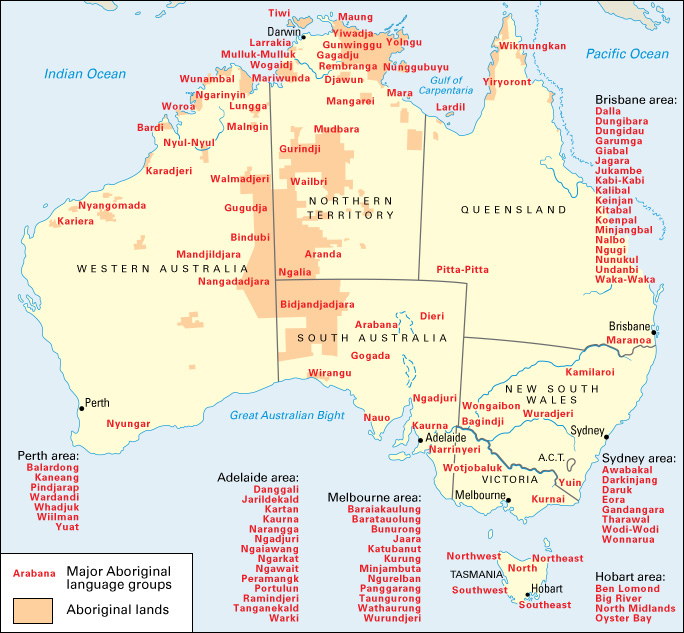
Scholars believe there were two main Aboriginal languages on Tasmania—one in the south and one in the north. However, the original Aboriginal languages of Tasmania survive only in word lists, place names, and several recorded songs. Some Indigenous communities in Australia are working to reclaim Indigenous languages. In Tasmania today, palawa kani is the name of a composite Tasmanian Aboriginal language based on words from original Tasmanian languages resurrected from historical sources. Some regions and landmarks in Tasmania have been given dual names, in palawa kani and English.
Trade.
The Aboriginal peoples of Tasmania traded ocher (colored earth used for painting), shells, shell necklaces, and stone good for making tools. They visited each other’s homelands to trade, especially when there was a seasonal abundance of food that could be shared with many people.
Hunting, gathering, and fishing.
The Aboriginal peoples of Tasmania ate a rich assortment of foods and were generally healthy and strong. They ate eggs and hunted such animals as kangaroos, wallabies, possums, seals, and birds. They gathered a variety of plant foods, including fern roots, tubers, fungus from the grass tree, and berries. The people ate some seafood, including abalones, oysters, mussels, and crayfish. For thousands of years, they fished the seas and rivers. Some scientists suggest that some Tasmanians stopped fishing about 3,500 years ago, although the experts do not know why this technology disappeared. Other scientists disagree with the theory that the Aboriginal Tasmanians stopped fishing.
The Aboriginal peoples of Tasmania traveled by sea around their island to visit and to hunt. They visited small islands several miles offshore, using canoe-shaped floats made of three rolls of bark and seaweed. A full-sized float measured about 10 feet (3 meters) in length.
Tools.
Aboriginal Tasmanians made tools and containers from wood, bone, stone, seaweed, bark, and grass, tied together with animal tendons. They made scrapers, knives, planes, and sawlike flakes from the fine-grained stones found throughout Tasmania. The men made spears and clubs. Women wove baskets from rushes (stems of grasslike plants), grass, and kelp. The people made ropes from grass and used them for climbing trees to hunt possums. Women’s digging sticks had sharp chisellike ends that they used to pry shellfish from the rocks.
Fire.
In Tasmania, as in mainland Australia, fire was an important tool, and people kept a slow-burning firestick lit at all times. They used fire to clear the land. This method of burning, called firestick farming, encouraged the growth of grasses and other vegetation that wildlife needed to eat and increased the variety of animal habitats. Animals were attracted to burned areas because of the new plant growth. Clearing the land by burning it also allowed for easier movement across the land. Hunters also used fire in hunting to drive animals where they could spear or club the animals.
Clothing and shelter.
Like Aboriginal peoples on the mainland, the inhabitants of Tasmania wore little clothing. However, parts of Tasmania are colder than the mainland. Aboriginal people in these colder regions protected themselves from the cold, damp winters by coating their bodies with a mixture of fat, ocher, and charcoal. In some areas, they wore kangaroo-skin cloaks. Tasmania’s Aboriginal people wore necklaces made of shells, kangaroo sinews covered with ocher, and strips of animal fur.
Aboriginal men and women in Tasmania marked their bodies with ornamental scars in line and circle designs. The patterns may have indicated membership in different bands or tribes. Women wore their hair short, and differences in their hairstyles probably identified their tribal identity. Men wore their hair in dreadlocks (long, entwined curls).
Tasmania’s Aboriginal peoples had two basic designs for shelters. In the eastern and northeastern sections of the island, people made temporary shelters of branches and bark. In the colder, windier regions of western and central Tasmania, they made dome-shaped dwellings of branches, thatched grass, and bark.
Art and music.
Tasmanian Aboriginal art consisted primarily of circles and curving lines used in painting and sculpture. The artists cut designs in stone and painted on the walls of caves and on bark using ocher and charcoal. They made stencils of their hands inside caves by placing a hand on the rock and spraying a mouthful of paint over it.
Singing and dancing were important parts of Aboriginal society in Tasmania. Songs and dances told stories about creation, war, love, the beauty of nature, and important people and events. Women often sang in three-part harmony. They accompanied themselves by beating two sticks together or drumming on rolled-up kangaroo skins.
Religion.
Tasmanian Aboriginal religion shared many common features with mainland Aboriginal religion. The Tasmanian Aboriginal people had totems—that is, natural objects, usually plants or animals, that they used as symbols for a tribe, band, or family. They also had taboos (actions, objects, persons, or places forbidden by law or culture). People told many stories about how the world and its animals and plants were created.
Tasmania’s Aboriginal peoples believed that each person had a spirit or soul that lived on after death. They used four different methods to dispose of their dead. The main one was cremation. Some groups placed the body on its side with its knees pulled up to its chin and buried it in a shallow grave in dune sand or soft earth. Others placed the body in a hollow tree and covered it with sheets of bark. The body might later be burned. A fourth method was to bury the body in a tomb formed of bark. People considered it taboo to mention a dead person’s name. Other traditional practices included wearing small bones of the dead on necklaces, and rubbing ashes from cremation on sick people to help them get better.
History
Aboriginal arrival.
Archaeological evidence shows that Aboriginal people settled in the southeastern tip of the Australian mainland by about 40,000 years ago. At that time, Earth was in the most recent ice age, a period when ice sheets covered vast regions of land. During ice ages, the seas grew smaller because more water was locked up in ice. Land bridges connected what is now the island of Tasmania to Australia. During the last ice age, the Tasmanians were the most southern human beings on Earth.
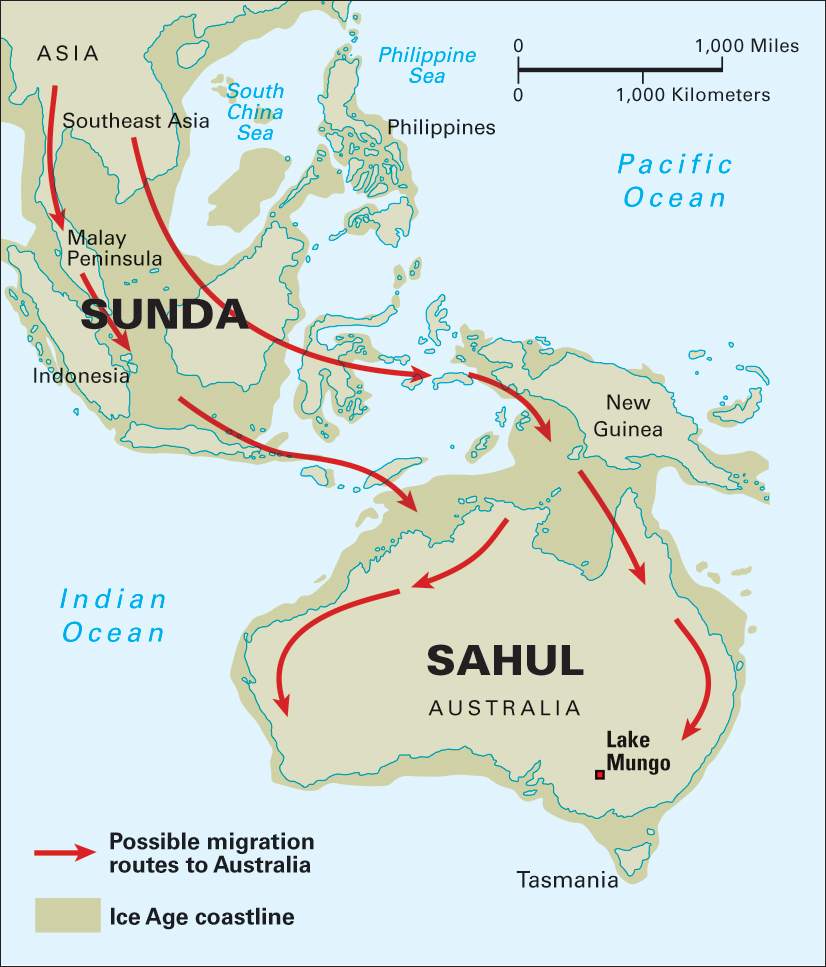
Average temperatures in Tasmania at the time of Aboriginal arrival were lower than they are today. The continents’ mountains were covered in snow and ice throughout the year. The ice age environment was generally drier as well. Areas that are now rain forests were then open areas where people hunted kangaroos and other animals.
As Earth’s climate warmed at the end of the last ice age, large sections of the world’s ice sheets melted. Sea level rose over a period of several thousand years. Water covered the land bridge between the mainland and Flinders Island, to the north of Tasmania, just under 14,000 years ago. Tasmania became a separate island about 12,000 years ago. As Tasmania became separated from the mainland, the Aboriginal people of Tasmania became isolated. From that time, the cultures of the peoples on Tasmania developed somewhat differently than those of the Aboriginal peoples on mainland Australia.
The arrival of Europeans.
On Nov. 24, 1642, the Dutch explorer Abel Tasman became the first European to see the island now named Tasmania when he sighted what today is called Cape Sorell, on the island’s west coast. He sailed around the southern part of the island, which he claimed for the Netherlands. Tasman named the island Van Diemen’s Land, in honor of the Dutch governor. However, the Dutch found Australia harsh and forbidding, with no opportunities for trade. They made no settlements on Australia, and no Europeans came to Tasmania for more than 130 years after Tasman’s sighting.
In 1772, the French explorer Marion du Fresne became the first European to meet the Aboriginal people of Tasmania. A misunderstanding between du Fresne’s crew and some Aboriginal people led to fighting in which several men from both sides were wounded. During the next 30 years, such explorers as the British naval officer and navigator James Cook, the French naval commander Bruni D’Entrecasteaux, and the French navigator Nicolas Baudin visited Tasmania’s shores. Most had friendly meetings with Tasmania’s people.
In 1803, Governor Philip Gidley King of the British colony of New South Wales on the mainland sent a party of settlers and convicts to establish a settlement on the Derwent River in southern Van Diemen’s Land. In 1804, colonists established settlements at the present site of Hobart and at Port Dalrymple, at the mouth of the Tamar River. This site, called York Town, was soon abandoned for George Town.
Warfare
between British settlers and the Aboriginal people of Tasmania erupted soon after the establishment of these first settlements. Aboriginal people speared shepherds and sheep. The European settlers kidnapped Aboriginal children and attacked the adults. As Tasmania’s Aboriginal inhabitants began to understand that settlers would take away their land, different groups banded together to fight the British colonists. Both men and women joined in the warfare.
Colonizers and Aboriginal people battled from 1824 to 1830. That year, Lieutenant Governor George Arthur decided that Tasmania’s Aboriginal peoples had so seriously obstructed the settlement of Van Diemen’s Land that they should be removed from most of the island. He organized a combined group of police, military, and civilians to form a line, called the Black Line, to force the island’s Aboriginal population into Tasman Peninsula in southeastern Tasmania. There the authorities could isolate them. About 3,000 soldiers, settlers, and convicts formed a human chain and walked across the settled areas. They did not kill any Aboriginal people and captured only two. Authorities viewed the project as an expensive failure.
Resettlement.
In 1834, government officials resettled about 200 of the surviving Aboriginal people of Tasmania on a reserve on Flinders Island. Colonial officials promised to provide the people with food, clothing, shelter, and a guarantee that they could maintain their traditional ways. However, many of the Aboriginal people moved to Flinders Island suffered from starvation, disease, and despair. Missionaries forcefully tried to convert them to Christianity. By 1842, 150 of the 200 Aboriginal people on Flinders Island had died.
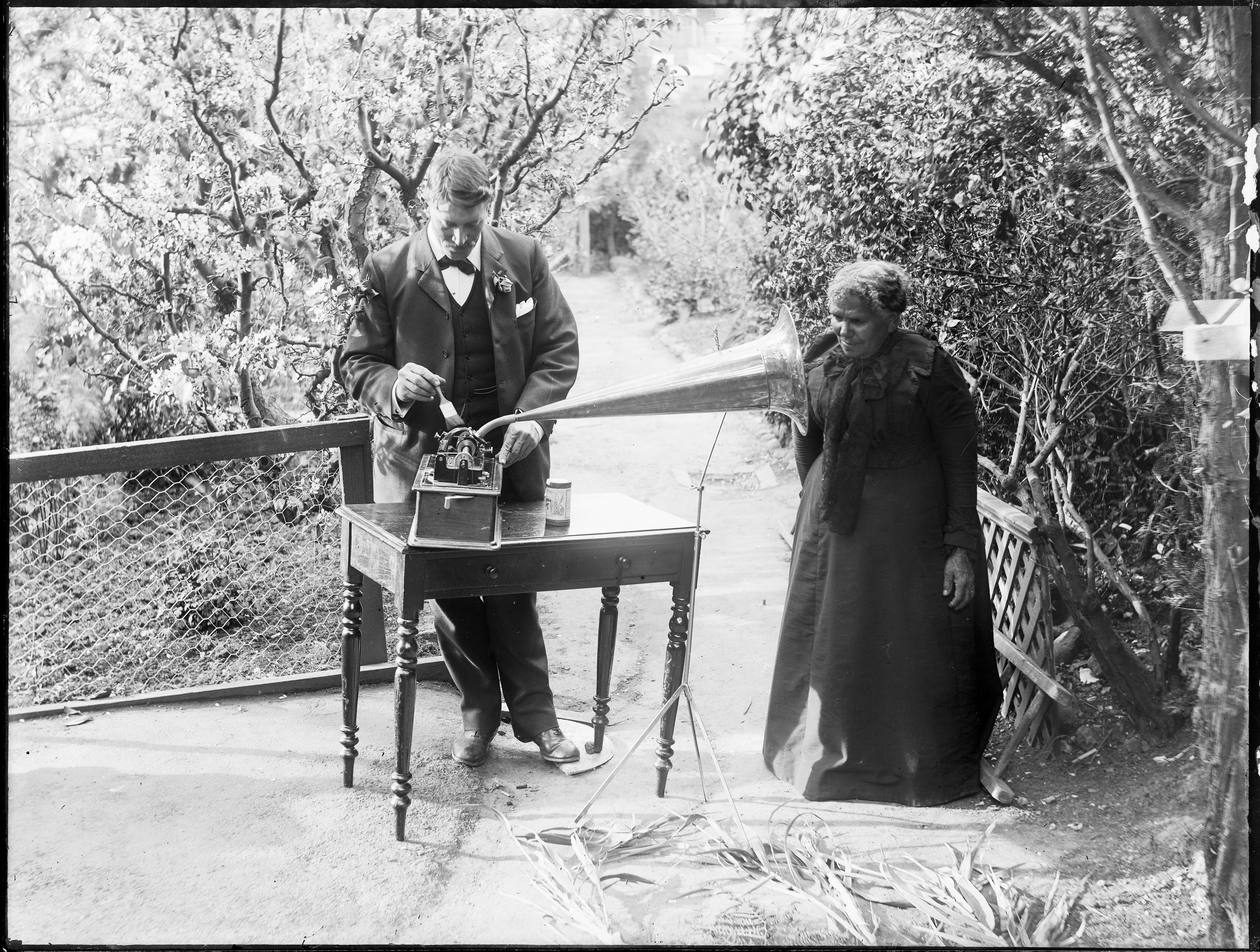
The remaining Tasmanian Aboriginal people claimed that the government did not honor its agreements. In 1846, they presented a petition to Queen Victoria appealing for the government to fulfill its commitments to them. In 1847, colonial authorities decided to move the Aboriginal people on Flinders Island back to the main island and settle them at Oyster Cove. By then, only 47 Aboriginal people of Tasmania were left.
Bass Strait community.
As the main population of Tasmanian Aboriginal people slowly dwindled, a smaller community developed on islands in the Bass Strait, a shallow area of water separating Tasmania from the mainland. In the early 1800’s, European sealers had kidnapped Aboriginal women to hunt mutton-birds and seals in the Cape Barren Islands of the Bass Strait. By the 1850’s, the sealers and Aboriginal women had formed families. Mutton-bird harvesting became the mainstay of the community. The people of the Bass Strait islands developed a way of life that was based on both traditional Aboriginal customs and European ones. The Aboriginal people of Tasmania today are the descendants of these Bass Strait island communities.
Aboriginal people of Tasmania today.
For many years, Tasmania’s government and the non-Aboriginal community ignored Tasmania’s Aboriginal people. Most non-Aboriginal people in Australia and in many other parts of the world mistakenly believed that a woman named Truganini who died in 1876 was the last Tasmanian Aboriginal person.
Through the 1900’s, the number of Tasmanian Aboriginal people slowly increased. Tasmanian Aboriginal people now live throughout Tasmania, with major communities in the Bass Strait islands, Burnie, Hobart, and Launceston. They are fighting for recognition of their existence and for their rights. Only since the mid-1900’s have they begun to achieve some of their rights as Aboriginal Australians, however.
In 1989, the Australian government established the Aboriginal and Torres Strait Islander Commission (ATSIC). ATSIC was an elected body that represented the interests of Australia’s Inidgenous people. The Australian government abolished ATSIC in 2004 and 2005. The programs and services provided by ATSIC were transferred to other government agencies. The Tasmanian Aboriginal Land Council (TALC), also formed in 1989, helps preserve and manage Aboriginal sites in Tasmania.
Aboriginal peoples of Tasmania, like those throughout Australia, seek to keep a close attachment to their traditions and culture. They consider the land an essential part of their physical, emotional, and spiritual well-being. The lands in Tasmania that Aboriginal people claim include all rock-carving and rock art sites, as well as Cape Barren Island and other mutton-bird breeding islands. Tasmania’s Aboriginal people also claim Cape Grim, the site of an 1827 massacre in which more than 30 Aboriginal people were reportedly killed by settlers in retaliation for an earlier Aboriginal attack on the settlers’ sheep.
The Australian government has returned a number of sites of spiritual significance to the Tasmanian Aboriginal people, including Oyster Cove, Risdon Cove, and Wybalenna on Flinders Island. The return of these traditionally important places and the joint management of other places of significance mark a new era of improved relations between Tasmania’s Aboriginal people and Australians of European descent. In 2008, the government of Australia issued a formal apology for past wrongs and for laws and policies that inflicted grief, suffering, and loss upon the Indigenous peoples of Australia, including the Aboriginal peoples of Australia and of Tasmania, and the Torres Strait Islander peoples.
Loading the player...Kevin Rudd delivers apology to Indigenous Australians
See also Lanne, William; Robinson, George Augustus; Smith, Fanny Cochrane; Tasmania (History).
